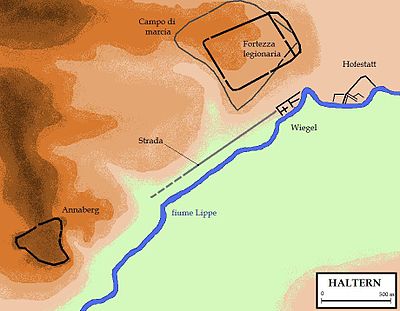User:Bljr/sandbox
ALISO
The legionary base of Aliso and the "Vicus": administrative seat of the new province of Germania
The first full archaeological research was done in 1901, by the archaeologists Friedrich Koepp, Friedrich Philippi and Carl Schuchhardt.

The first investigation started from the double moat present around the camp, where both ditches were 6 meters wide and deep 2.5 meters deep. Inside the ditches there was an embankment and a palisade that enclosed an area of 16.3 hectares, then expanded along the east side of the field for another 2 acres of surface. The area of the new rectangular field with beveled corners now measures more than 18.3 hectares (560 x 380 m). It also had 4 wide doors, between 7 and 10 meters high.
The subsequent excavations that occurred before the First World War revealed: all four main roads in the castrum, namely Via Principalis, Via Praetoria, Via Decumana and Via Quintana. The first was 30 meters wide, the second 45 meters, while the other two were wide up to 20 meters. Parallel to the palisade ran Via Sagularis.[1]
Some buildings were later investigated, such as the Principia administrative center, the commander building (Praetorium), the Tribune and Centurion dwellings, the Military Shops (Contubernium), the Military Hospital (Valetudinarium), the Warehouses and the Laboratories of a potter.
This fortification was part of a series of strong auxiliary and legionnaires castra along the Lippe river, from the Rhine until Anreppen. But Aliso, however, also covered the role of administrative center of the new Roman province of Germany. The area of the fortifications suggests that 6-7 cohorts (of Legio XIX) could be accommodated, as well as a few "Auxilia" contingents on horseback, possibly placed in the nearby fort of Annaber.
Aliso (now Haltern) was founded....Here, however, there are characteristics that exclude a purely military destination: the high number above the average of the so-called centurion and tribune houses, as well as the presence of front porches, indicate a civil use, in any case very little compatible with a situation of open belligerence....In addition, the tombs built in front of Aliso's main towers do not look like hurried burials, as if they were carried out during a military mission, but served as long-lasting memory sites for the dead. Those who built such tombs left the assumption that they could continue to visit these burial grounds for a long time. This means that the camp had to be for a long time a housing center not only for military but also for civilians Werner Eck; University of Bologna [2]
The Romans believed that the countryside along the river Lippe was a safe possession of their empire. This is suggested by the fact that they built tombs in this area [3]. These tombs were evidently built for a resident population who wanted to honor their deaths for generations. In the XX century were discovered numerous tombs of the Augustan era on a 500-foot long and 45 meters wide strip, along the south-east corner of the Roman castrum and near the "Canaba" Vicus. Indeed Aliso played an important role in the administration of the subjected territories, because the camp had too many large houses not for military use. Probably the "Vicus" in 9 AD -when Aliso was attacked by Arminius- had a population of nearly one thousand inhabitants, with many women and children.
It is likely that at least some Roman civil servants, responsible for tax and similar activities, lived in Aliso. Furthermore, the Auxilia troops were mainly Gallo-Romance soldiers with their families, who settled in the Aliso Canaba/Vicus and probably remained in the area after the Roman withdrawal in 16 AD [4].
